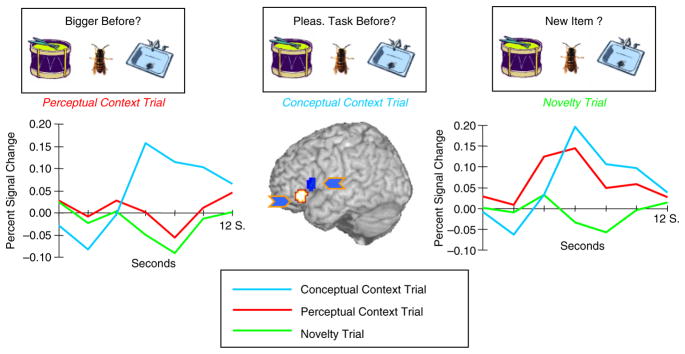Fig. 3.
Functional specialization of the left ventrolateral prefrontal cortex (PFC) during memory retrieval attempts. Subjects answered one of three different memory questions for triplets of items. Critically, two of the three items had been studied and one was novel. For the two studied items, one was previously bigger in size compared to its size in the test triplet, whereas one was previously smaller in size compared to its size in the test triplet. Additionally, during prior study, the two old items were rated using different semantic encoding tasks. Whereas one item was rated as pleasant or unpleasant, the other was rated as either living or nonliving. The previous size and type of prior rating task were fully crossed for the two studied retrieval probes of each test triplet. (The object triplets seen during each retrieval trial were different, although identical objects are shown in the figure for simplification.) During retrieval, when the question above the triplet read “Bigger Before?”subjects were to select the item that was perceptually bigger when previously studied. Because it is only the prior perceptual features of the items that are relevant, and not the prior rating task performed on the items, these trials are labeled Perceptual Context trials. In contrast, when the question read “Pleas. task before?” subjects were to select the item that was rated as pleasant or unpleasant when previously studied. Now the prior perceptual sizes of the probes were irrelevant and instead subjects were to recover prior conceptual context information (Conceptual Context trials). Finally, when the question read “New Item?” they were to select the item that had not been viewed before, and it was assumed that neither prior perceptual nor conceptual context information would be retrieved (Novelty trial). The line plots show the reconstructed blood oxygenation level dependent (BOLD) responses observed in two areas of the left ventrolateral PFC during the three different types of retrieval questions. In the anterior site (left graph), activation during Conceptual Context trials was greater than during Perceptual Context and Novelty trials. These latter two trials failed to deviate from baseline and overall this suggests that this region was uniquely involved in recovering memories related to conceptual features of the items. In contrast, the more posterior ventrolateral PFC region (right graph) showed activation for both Conceptual and Perceptual Context trials, suggesting a more general role in context-memory retrieval. Thus the pattern of activation observed in the left ventrolateral PFC critically depended upon what the subjects were attempting to recover about their prior experiences; the left anterior ventrolateral PFC appeared to be uniquely tied to elaborating the conceptual features of the probes (Dobbins & Wagner, 2005).

